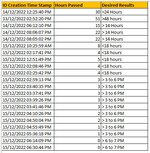farhan11941234
New Member
- Joined
- Dec 14, 2019
- Messages
- 29
- Office Version
- 365
- Platform
- Windows
Please help me out to figure out a formula to calculate Date/Time Base Bins (See attached Image).Whenever The ID Creation(Column A) on Current Day and Time 3:00 PM to 6:00 PM, In Column C "> 3 to 6 PM" , Current Date and time between 6 to 7 PM in Column C result should be " > 6 to 7 PM", after 7:00 PM , in Column C should be "> 7:00 PM onwards.
when time > 14 Hours it should be >14 Hours and continue the this logic to >24 and >48 hours.
I would be very thankful to help me devolope the formula for this.
Sorry, for not using the XL2BB becuase of the admin Limitations.
Thanks
when time > 14 Hours it should be >14 Hours and continue the this logic to >24 and >48 hours.
I would be very thankful to help me devolope the formula for this.
Sorry, for not using the XL2BB becuase of the admin Limitations.
Thanks






